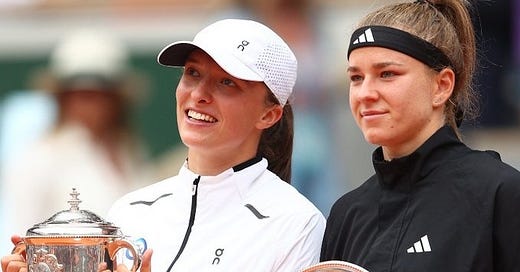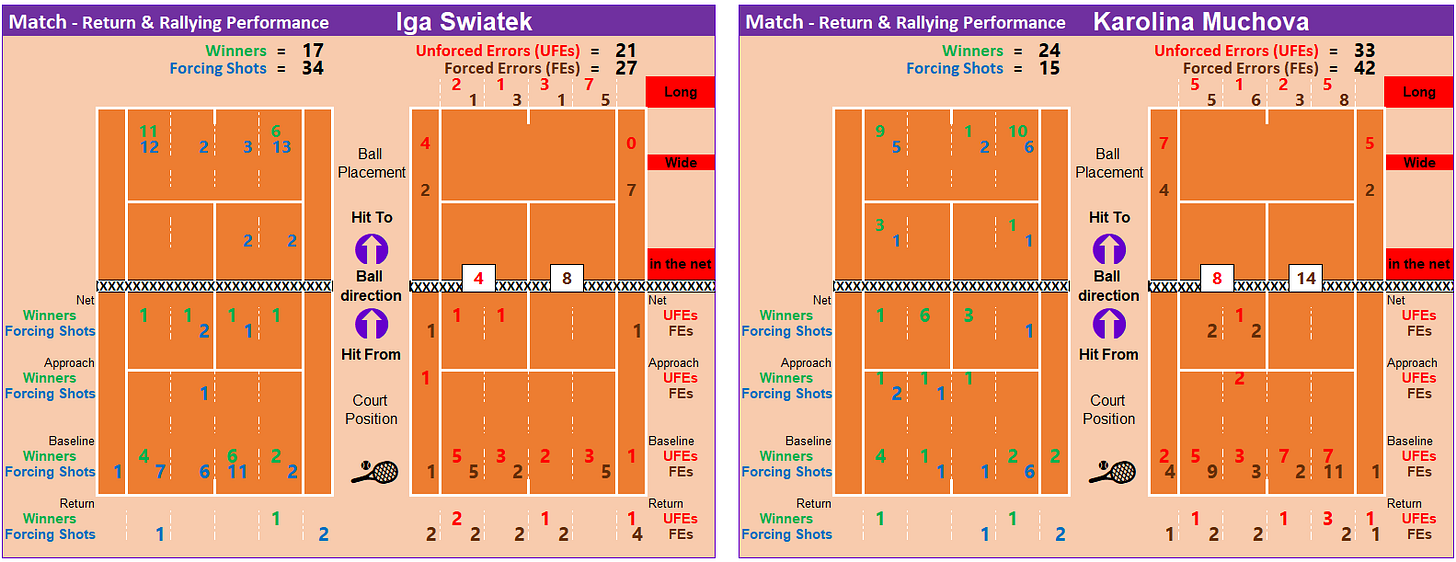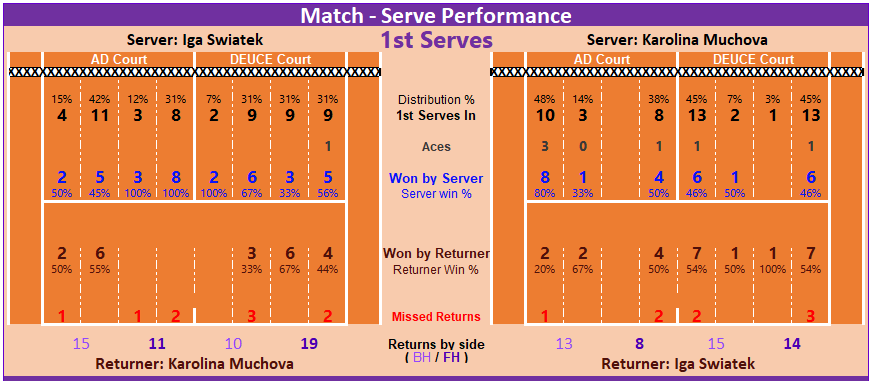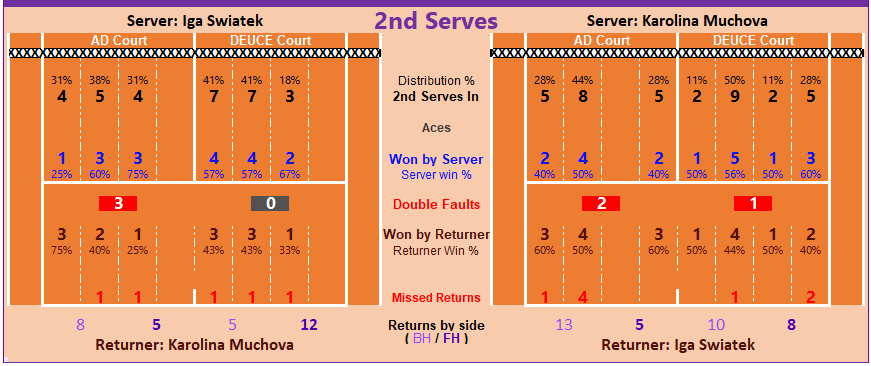Swiatek vs Muchova: Roland Garros Final Analysis
A Paris three-peat for Iga Swiatek conquered in the hardest of her Grand Slam finals.
Three was the charm for Iga Swiatek at the 2023 French Open final. She achieved her 3rd Roland Garros title by battling through 3 sets in a Grand Slam final for the first time, breaking Muchova 3 times in the deciding set and winning the last 3 games of the match.

Match Story
Swiatek jumped to a 3-0 lead en route to a comfortable 6-2 score in set 1. Once she replicated her 3-0 start in set 2, very few would deny we were witnessing another dominant performance by the world #1 that would be over very soon.
But Karolina Muchova, even if affected by early nerves, made use of all her craft to convert her first Grand Slam final into a very competitive match. Fresh from escaping match-point in the semi-final against Aryna Sabalenka, Muchova staged a comeback with more accurate, attacking tennis that heaped pressure on Swiatek. No shot was better than Muchova’s magical backhand volley at full stretch in the 11th game that set up her 3rd and decisive set point. She closed the set 7-5 after failing to serve it out the first time at 5-4.
Muchova was brimming in confidence and it showed as she won the first 8 points of set 3. If Swiatek was suddenly in trouble, spraying a few more unforced errors than usual, she never panicked. Resorting to all her mental strength, Swiatek first levelled at 2-2 and later on, after Muchova had taken a 4-3 lead, broke back immediately to square the set at 4-4. Swiatek’s clutch play continued in the 9th game as she saved a break point before completing a tight hold. Over the last 2 sets, that was the only game that featured break point and did not materialize into a break. It left Swiatek one game from triumph and she increased the pressure on Muchova by forcing 2 errors in the first two points of the 10th game. This time Muchova could not produce another comeback and the match ended on a Muchova double fault.
Decisive Numbers
In a fascinating match with plenty of twists and drama, Swiatek tried to exert baseline dominance by controlling exchanges with topspin strokes, shot tolerance and counter skills. In contrast, Muchova used all her talent to be disruptive, play with variety, attack the net or force Swiatek away from the baseline.
The clash of tennis styles did not disappoint and offered a lot of interesting data. Here is a look at how Muchova tried to unsettle Swiatek:
Drop shots
Muchova hit 19 drop shots, winning 12 points (63%). For comparison, as usual, Swiatek did not attempt a drop shot.
Serve & Volley
Muchova serve & volleyed 5 times, winning all 5 points. She served wide on all points (twice on the Deuce side, three times on AD side).
Set 1: 1-4 Deuce (missed return)
Set 2: 0-3 40/30 (serve+1 BH volley winner)
Set 2: 3-4 30/15 (serve+2 overhead winner)
Set 2: 6-5 Deuce#2 (serve+3 BH volley winner)
Set 3: 2-1 0/40 (serve+2 BH volley winner)
Net approaches
Muchova approached the net during 27 rallies. She won 15 points, for a 56% win percentage. Muchova won 8 of 11 net approaches on return points (73%) and 7 of 16 net approaches on serve points (44%).
Muchova became the first to push Swiatek to a third set in a major final. But her efforts were still not enough as she could not take away baseline dominance from Swiatek.
Swiatek won 63% of baseline points (67 won in 107). The score on 83 baseline duels was 55-28 in favour of Swiatek.
Ultimately, this was the key factor that led Swiatek to victory.
A closer look at the numbers from each set reveals some interesting match dynamics:
Swiatek: baseline win % by set = 75% / 56% / 61%
Muchova: baseline win % by set = 25% / 43% / 32%
In set 1, Muchova played 28 baseline points (won only 25%) and she attackted the net on 14 occasions. Was Muchova’s baseline rate low because she was rushing too much (accumulating 12 unforced errors), anxious to get to the net?
In set 2, Muchova’s point distribution suggests more patience: she played 44 baseline points and 12 net points. Muchova was efficient when moving forward (won 67% of net points) and she complemented it with an increase in baseline success to 43%. It might seem relatively low but it enough of an improvement for Muchova to win the set.
Under pressure in set 3, Swiatek got her FH groundstroke more involved:
Swiatek: % of groundstrokes hit as FHs by set = 48% / 49% / 61%
Muchova: % of groundstrokes hit as FHs by set = 52% / 56% / 54%
While rallying, Swiatek hit 61% of groundstrokes as FHs in the deciding set, 12% more than in the previous 2 sets. By striking more FHs, Swiatek dictated rallies and prevented Muchova from moving forward. Muchova was limited to 6 net attacks (including one S&V point). In fact, Swiatek ended up approaching the net a lot more than her opponent during the final set (11 points, winning 7).
Unable to attack the net frequently, Muchova compensated by serving better. In the third set, she delivered 43% of unreturned 1st serves and 31% of unreturned 2nd serves. The problem for Muchova was winning points once Swiatek put returns in play:
Muchova won 13 serve points; 10 were unreturned serves.
Swiatek returned 16 of 26 serves; she won 13 points.
These numbers were particularly significant as Swiatek had to recover from a break down twice during a tension-filled final set. Swiatek struggled on serve throughout but she kept digging her way out.
Once match point was over, Swiatek crouched down on the clay in tears savouring a hard-earned victory that must have tasted that much sweeter.

Swiatek described the final as a roller coaster.
“I'm feeling all these different emotions right now. It's pretty surreal, everything. The match was really intense, a lot of ups and downs. Stressful moments and coming back, you know. So I'm pretty happy that at the end I could be solid in those few last games and finish it.
But Karolina really played well. It was a big challenge. I'm happy and really proud of myself that I did it.”
— Iga Swiatek, from Roland Garros website
Although the match featured Swiatek’s first lost set of the fortnight and her first lost set in a Grand Slam final, it brought her several accolades.
Swiatek became the only singles player in the Open Era to win the first seven sets played in Gran Slam finals. She joined Monica Seles and Naomi Osaka as the only women to win each of their first four Grand Slam finals.
For the first time in 7 years, there was a successful Grand Slam title defense.
With an hat-trick of titles in Paris since 2020, Swiatek improved her win-loss record over that period to 25-1.
Her all-time record at Roland Garros stands at 28-2, in 5 participations. It gives Swiatek an impressive 93.3% win-percentage, only bested by Margaret Court’s 95.5%.
Simply astonishing numbers for a 22-year old!
Iga Swiatek (WTA #1, seed 1) vs Karolina Muchova (WTA #42)
Roland Garros Final - Match Data
Rally Length
Average rally length for the match was 4.55 shots per point.
There were 2 points that lasted 19 shots.
Points won by Rally Length
Swiatek had the edge on all three rally length intervals.
Swiatek’s advantage grew as points lasted longer.
On long rallies, Swiatek finished with an 8-point advantage (she won 16 of 24 points).
Strokes Breakdown

Clear differences in groundstroke performances are evident in the Strokes breakdown table.
Swiatek’s FH was the only groundstroke with a positive score (+3.5). A large part of it was due to 21 forcing FHs.
There was a 15-point advantage for Swiatek in our groundstroke FH performance score (+3.5 vs -11.5) and a 10.5-point difference in our groundstroke BH score (-5.5 vs -16).
Muchova struck a total of 27 volleys and overheads. She hit 12-winning shots and 7 errors.
Winners and Errors
Helped by 9 netplay winners, Muchova ended the match with 24 winners, 7 more than Swiatek’s total of 17.
Swiatek made 12 less UFEs (21 vs 33) and she was able to induce 15 more forced errors on Muchova (27 vs 42).
Rallying performance maps
Serve & Return
Players struggled to hold serve. In total, there were 12 breaks. Half of the match’s 30 games featured at least a BP.
Swiatek won 58% of serve points and 51% of return points.
Swiatek was above 50% on 2nd serve points won (52%).
1st Serves
Swiatek favoured serves to the FH on the Deuce side, with some “body BH” serves as variation. On the AD side, she switched between “body BH” and down the T serves.
On the AD side, Swiatek won all 11 points she directed to FH returns (combined numbers of FH and “body FH” serves).
Muchova opted for wide or down the T 1st serves.
Muchova was more successful when delivering wide serves on the AD side (won 80%).
2nd Serves
Swiatek hit a few jamming “body FH” 2nd serves but she avoided 2nd serves sent directly to the FH side of Muchova. Still, Muchova made several run-around FH returns, in particular on the Deuce side.
Muchova varied between going for the corners (as she did in 1st servers) and delivering a few “body BH” 2nd serves.
Points won breakdown
This final section gives a last, broader look at the match by presenting how each player won points. Points are listed according to their frequency (highest to lowest) and are named in relation to the last touch on the ball. For simplicity, groundstrokes hit from the 5th shot onwards are grouped together.
Breakdown by side (FHs or BHs)

Breakdown by error type (UFEs or FEs)
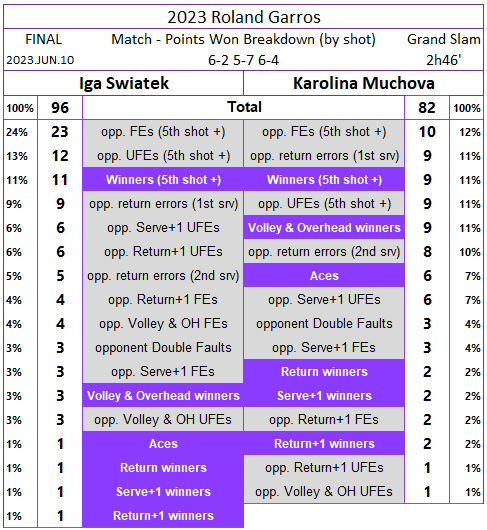
Thumbnail photo credit: Roland Garros Twitter.
To find out more about the stats published here, please visit the following post.
Even though they follow the same criteria used on all major tennis events, they are not official WTA or ITF stats. They are collected through our own rigorous video analysis.

